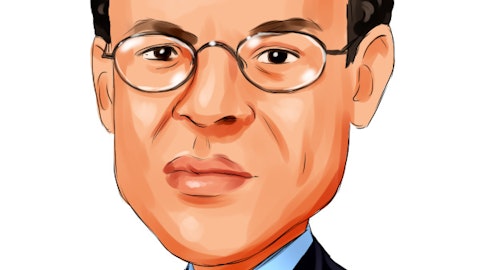Peter Orszag: Well, we’ll find the right time to do that. We want to do that when there are some stepping stones and proof points already in hand. And so it’s not just plans, but you’re starting to see the beginning of action also. But I think you should expect the normal things that 1 would look to in terms of monitoring how the business is operating. So beyond revenue and earnings things like how we’re expanding in the growth areas that we see, and on the Asset Management side of the business, how we’re doing on improving performance within the existing business and moving into adjacencies.
Steven Chubak: Any numbers you can put behind it, Peter?
Peter Orszag: At the right moment, yes, and now is not the right moment.
Operator: We’ll take our next question from Jim Mitchell with Seaport Capital — Seaport Global. Please go ahead. Your line is open.
Jim Mitchell: Peter, just on your comments around funding future MD headcount growth with improved productivity, can you kind of discuss kind of what your analysis was to kind of feel comfortable that whether it’s $1 million or more in terms of per MD improvement? You feel comfortable that’s achievable relative to whether it’s competitor analysis or how you’re thinking about it?
Peter Orszag: Sure. Let me start with, I think, a really important point, which I also briefly mentioned, which is, we have a significant amount of embedded growth and also productivity enhancement that will come from the disproportionate share of Managing Directors today who are just ramping up the productivity curve. So in normal years, historically going back, we’ve had about 30% or so of our managing directors being in that kind of new category, either lateral or newly promoted. Today, it’s 40%. That 10% differential is a very large change. Those people, the newer people are disproportionately in areas that we see as exciting opportunities going forward, our Lazard Capital Solutions group, a revamped effort in Germany, expanded coverage of private capital, large investments in biotech and energy, our new team in the Middle East and then also our geopolitical team, which is best-in-class on Wall Street and is leading — it is reinforcing Lazard’s historical dominance in firms that are looking for the combination of business and geopolitical insight.
And I think in today’s world, that’s an extremely valuable thing. So the first part is just depreciation for the embedded growth and productivity pop, if you will, that we have as they move forward in their ramp. The second is the — all the various things that I mentioned. It’s not going to be 1 thing, but many different things from the fees that we charge to more aggressive culling of less productive tenured MDs. So actually, just to return to the former topic. One of the reasons why we have that different mix today, part of it is the investments that I just mentioned, the new lateral hires and also newly promoted managing directors in those areas. But partly, it’s also we have started earlier this year, and we will continue to do this to be extremely rigorous about culling lower productivity managing directors each year.
After a sufficiently sufficient period of time, if a banker is not — I’ve talked about being commercial and collegial. Both of those are super important. And if we have some who’s not living up to either end of that, Lazard is not going to be the right place for them. So multiple different pathways, but mostly, it comes back to excited about the areas that we’re investing in. Some embedded growth already that may not be apparent above the surface, and then really active management and being very committed to achieving the productivity improvement that will create the flywheel of reinforcement — reinforcing resources that allow us to do another round of investments.
Jim Mitchell: Maybe just on the follow-up on — I know it’s not an easy question or one you can put a hard number on. But I think everyone is struggling with the timing of the revenue rebound if we get it and comp ratios and you guys are cutting 10% of your headcount. Is there a way for us to box around next year in terms of whether it’s an absolute dollar amount of comp that needs to be accrued or just how to think about the parameters for the comp ratio?


